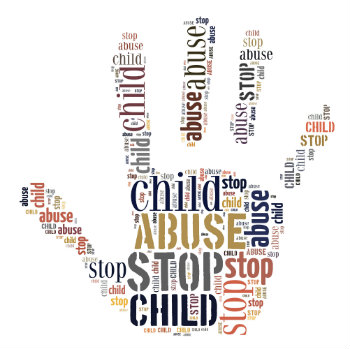Child Abuse and Neglect
 Article 19 of the Convention on the Rights of the Child (CRC) obligates governments to protect children from all forms of physical or mental violence, injury or abuse, neglect or negligent treatment, maltreatment or exploitation, including sexual abuse, while in the care of parent(s), legal guardian(s), or any other person who has the care of a child. Article 19 of the Convention on the Rights of the Child (CRC) obligates governments to protect children from all forms of physical or mental violence, injury or abuse, neglect or negligent treatment, maltreatment or exploitation, including sexual abuse, while in the care of parent(s), legal guardian(s), or any other person who has the care of a child.
To date, the United States stands alone as the only country in the world that has not ratified the CRC. Although the United States has not committed itself legally to the fundamental protections of the CRC, surely it and every other government has a moral responsibility to protect its youngest citizens. After all, they're our future!
How many children are abused or neglected?
Annually, the Children's Bureau of the U.S. Department of Health and Human Services collects data from the 50 states, the District of Columbia, and the Commonwealth of Puerto Rico on the prevalence of child abuse and neglect. In Federal Fiscal Year 2017 (FFY 2017), states reported that:
- An estimated 4.1 million referrals involving approximately 7.5 million children were received by state child protection service agencies.
- Approximately 3.5 million children were the subject of at least one report of child maltreatment.
- An estimated 674,000 children were estimated to be victims of child abuse and neglect.
- The majority of children reported to child protective services were victims of neglect (74.9%), while 18.3% were victims of physical abuse.
Source: U.S. Department of Health & Human Services, Administration for Children and Families, Administration on Children, Youth and Families, Children’s Bureau. (2019). Child Maltreatment 2017. Available from https://www.acf.hhs.gov/cb/research-data-technology/statistics-research/child-maltreatment.
Why should child abuse and neglect be treated as a public health problem?
Historically, child abuse and neglect has been treated as a social and legal problem. However, there is a growing consensus that the traditional approach of investigating allegations, followed by the possibility of removal of the child, is too little, too late. Several factors about child abuse and neglect argue for a public health approach to the problem:
- Prevalence – the sheer number of children affected by child abuse and neglect demands a preventive approach. In the United States, it has been estimated that 1 in 5 children experience child maltreatment.
- Health consequences – children who are abused or neglected often experience lasting consequences ranging from injury, cognitive impairment, problems in school, and risky health behaviors, to poor physical and psychological health (e.g., anxiety, depression, substance abuse, self-directed violence) as adults.
- Neglect – Nearly 75 percent of the reports to child protective services agencies are for situations involving neglect. This may include leaving children alone for a period of time while parents go to work, not having enough food to eat, failure to provide adequate health care, living in housing that is inadequate, failure to meet the child's educational needs, or failure to provide emotional support, love, and affection to a child. These are issues that can be prevented with adequate support for families.
- Costs to society – Child abuse and neglect is costly to society. It's hard to know exactly how costly child maltreatment is. In 2012, the CDC estimated the total lifetime costs of new cases of child maltreatment (physical, sexual, and psychological abuse and neglect) at approximately $124 billion. The estimated lifetime cost per victim includes childhood health care costs, adult medical costs, lost productivity, child welfare costs, criminal justice costs, and special education costs. Learn more about the economic impact of child maltreatment.
These factors, along with the realization that child abuse and neglect are entirely preventable, have led to a growing consensus that child maltreatment is a public health concern. The public health field is concerned with protecting the health, safety, and well-being of entire populations by preventing problems. Public health agencies have the capacity to facilitate collective action in addressing problems by bringing together diverse community stakeholders.
What can be done to prevent child abuse and neglect? 
The prevention of violence against children requires understanding the factors that contribute to risk for violence. Risk can be individual, but it also arises in the context of the family, the community, and in society. The social-ecological framework used by the Centers for Disease Control helps to illustrate the interplay of these factors and the likely impact of potential strategies for preventing child maltreatment.
Examples of Effective Interventions
Consistent with a public health approach, interventions to prevent child maltreatment may involve strategies that can be classified as primary (e.g., universally applied), secondary (e.g., targeted to populations at risk of child maltreatment) or tertiary (e.g., targeted to populations already identified by the child protective service system).
CDC Essentials for Childhood
Essentials for Childhood is an initiative designed to promote relationships and environments in neighborhoods and communities in which every child can thrive. Learn more about the framework.
MST-CAN (Multisystemic Therapy for Child Abuse and Neglect)
MST-CAN is an intensive intervention for families who have come to the attention of the child protective service system. Learn more at the California Evidence-Based Clearinghouse.
Nurse Family Partnership
Nurse Family Partnership deploys specially trained nurses to work with first time moms, usually low-income and unmarried, to help them succeed in parenting. Learn more.
Safe Families for Children
Safe Families for Children mobilizes volunteers to host children and to provide support to caregivers during times of crisis.
Strong Communities for Children
Strong Communities is a community-based initiative to prevent child maltreatment and promote child safety. The primary intervention is the use of outreach workers to engage the community in supporting families. Learn more about Strong Communities at:
|

 Article 19 of the
Article 19 of the 